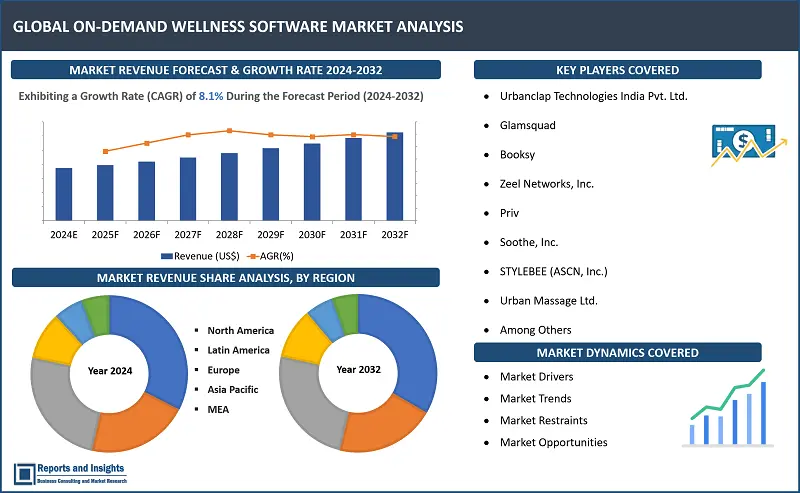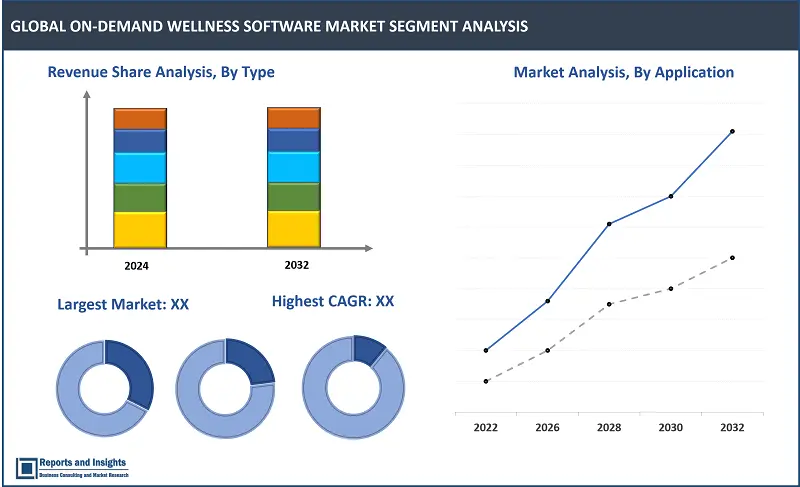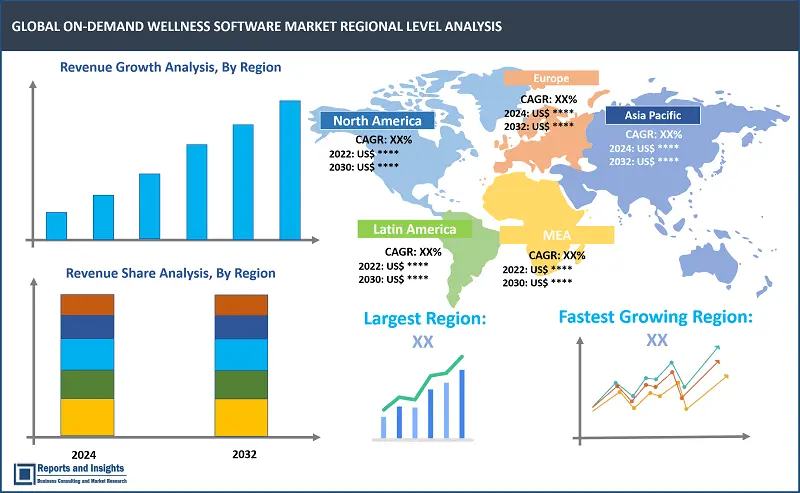Market Overview:
"The on-demand wellness software market size reached US$ 435.0 million in 2023. Looking forward, Reports and Insights expects the market to reach US$ 876.8 million in 2032, exhibiting a growth rate (CAGR) of 8.1% during 2024-2032."
|
Report Attributes |
Details |
|
Base Year |
2023 |
|
Forecast Years |
2024-2032 |
|
Historical Years |
2021-2023 |
|
Market Growth Rate (2024-2032) |
8.1% |
On-demand wellness software offers users the convenience of booking wellness services from independent professionals who can travel to their preferred location. These services can be delivered by either independent wellness experts who are part of the platform or internal service providers exclusive to the platform.
The market is witnessing significant growth due to the increasing preference among users for wellness services that can be enjoyed in the comfort of their homes or other preferred locations. Additionally, the software creates a marketplace for wellness professionals to advertise and offer their services, enhancing accessibility and visibility for both providers and users.
In recent years, the demand for wellness software has surged as a result of increased digital engagement and the flourishing trends in beauty and wellness. With consumers increasingly prioritizing healthier lifestyles, the wellness industry has become highly appealing to investors, mainly due to the technology-driven innovations that have facilitated market penetration.

On-Demand Wellness Software Market Trends and Drivers:
Surging Demand for Convenient Wellness Solutions: The fast-paced and busy lifestyles of individuals have sparked a notable increase in the demand for on-demand wellness software. These platforms offer the convenience of accessing wellness services at any time, eliminating fixed appointments and the need to travel to wellness centers.
Growing Popularity of Mobile Applications: The widespread use of smartphones and the availability of high-speed internet have fueled the growing popularity of on-demand wellness software. Mobile applications make it effortless for users to access and utilize wellness services on the go, elevating the overall user experience.
Personalization and Tailored Experiences: On-demand wellness software empowers users to personalize their wellness journeys by choosing specific services, preferred professionals, and scheduling options. This customization feature boosts user engagement and satisfaction, driving the widespread adoption of these software solutions.
Integration of Wearable Devices and IoT: The seamless integration of wearable devices, such as fitness trackers and smartwatches, with on-demand wellness software enables users to monitor their health metrics and receive personalized recommendations. The Internet of Things (IoT) further enhances the capabilities of on-demand wellness software by connecting multiple devices and delivering smooth user experiences.
On-Demand Wellness Software Market Restraining Factors:
Internet Connectivity Challenges in Remote Areas: Limited internet connectivity in certain regions poses a significant challenge for accessing on-demand wellness software. The absence of high-speed internet infrastructure hampers market growth in remote areas.
User Adoption and Engagement as Key Determinants: The success of on-demand wellness software hinges on user adoption and engagement. To drive user acquisition and retention, market players must continuously enhance user experiences and implement effective promotional strategies.
Compliance and Data Privacy Concerns: Ensuring regulatory compliance and safeguarding data privacy are critical for on-demand wellness software providers. Meeting healthcare regulations and securing user data can be complex and costly, presenting challenges in the market.
Intense Competition and Fragmentation: The on-demand wellness software market is fiercely competitive, featuring numerous startups and established players vying for market share. The highly fragmented nature of the market intensifies competition, making it difficult for newcomers to establish themselves.
Unavailability of Certified Professionals: Ensuring a sufficient pool of certified professionals on on-demand wellness software platforms can be challenging, particularly in certain regions or specialized fields. Maintaining an adequate supply of qualified professionals is vital for market growth and user satisfaction.
On-Demand Wellness Software Market Opportunities:
Emphasis on Mental Health and Well-being: The increasing awareness and recognition of the importance of mental health have created a growing demand for mental wellness services. On-demand wellness software providers can seize this opportunity by offering a diverse range of mental health support services. These may include virtual therapy sessions, meditation and mindfulness exercises, stress management programs, and emotional well-being resources. By catering to the specific mental health needs of users, these providers can address a crucial aspect of overall wellness and attract a larger user base seeking mental health support.
Emerging Market Expansion: Emerging markets present significant growth opportunities for on-demand wellness software providers. These regions often have a large population with increasing smartphone adoption rates, creating a substantial user base for wellness services. By expanding into these markets, providers can tap into a previously untapped audience and establish a strong presence. To succeed in emerging markets, providers may need to adapt their offerings to suit local preferences and cultural norms, as well as overcome potential challenges related to infrastructure and language barriers.
Synergistic Partnerships and Collaborations: Collaborations between on-demand wellness software providers and stakeholders in the wellness industry can lead to mutually beneficial partnerships and enriched service offerings. For instance, partnering with fitness centers and spas allows providers to offer integrated wellness packages that combine both physical and mental well-being services. Additionally, collaborating with healthcare providers enables seamless integration of health data and personalized wellness recommendations. These synergistic partnerships can enhance user experiences, increase service offerings, and drive customer loyalty.
Leveraging Artificial Intelligence (AI): The integration of AI technologies like machine learning and natural language processing can significantly augment the capabilities of on-demand wellness software. AI algorithms can analyze user data to provide personalized recommendations for wellness services tailored to individual needs and preferences. For example, AI can identify users' specific wellness goals and curate a personalized fitness and nutrition plan accordingly. By leveraging AI-driven insights, providers can enhance user engagement, satisfaction, and retention.
Targeting Corporate Wellness Programs: On-demand wellness software providers can strategically target corporate wellness programs to expand their user base and revenue streams. By offering customized wellness solutions designed for employees, such as fitness challenges, stress management programs, and mental health resources, providers can cater to the growing demand for corporate well-being initiatives. Such offerings can improve employee productivity, morale, and overall well-being, making them appealing to employers seeking to enhance their workforce's health and performance.
Market Segmentation:

By Type
- Cloud-based
- Web-based
By Application
- Large Enterprises
- Small & Medium Enterprises
By Region:

- North America
- Latin America
- Europe
- Asia Pacific
- Middle East & Africa
In 2023, North America dominated the on-demand wellness software market, accounting for over 40% of the total revenue. This region's strong position can be attributed to technological advancements and the surging demand for online wellness services. Factors like stress, sedentary lifestyles, limited time for social activities, and unhealthy lifestyle choices have led to a rise in chronic illnesses, driving the demand for on-demand wellness services.
Germany has emerged as the dominant player in the on-demand wellness software industry in Europe. The increasing demand for wellness software can be attributed to the growing digital engagement and the expanding trends in wellness and beauty. Consumers are increasingly seeking a healthier lifestyle, leading to a surge in demand for wellness services. In the U.K., the wellness industry has become highly attractive to investors due to technological innovations that are facilitating market penetration.
The Asia Pacific region is projected to witness the fastest compound annual growth rate (CAGR) from 2022 to 2030. Within this region, Japan, China, and India play a significant role in driving technological developments. Moreover, the Asia Pacific boasts the highest number of spas and wellness centers, with wellness tourism experiencing remarkable growth. The region's rapidly evolving economies, increasing awareness about wellness, flourishing wellness tourism industry, and growing adoption of digital booking platforms are key factors propelling the market's growth in this area.
Leading On-demand Wellness Software Providers & Competitive Landscape:
The landscape in the global on-demand wellness software market is characterized by presence of several key players, thus adding to the level of competitiveness. These companies focus on technological advancements, product innovation, and strategic collaborations to gain a competitive edge. Market competition is driven by factors such as pricing, product performance, customer service, and global market reach, leading to a dynamic and evolving competitive environment.
Company List:
- Urbanclap Technologies India Pvt. Ltd.
- Glamsquad
- Booksy
- Zeel Networks, Inc.
- Priv
- Soothe, Inc.
- STYLEBEE (ASCN, Inc.)
- Urban Massage Ltd.
Research Scope
|
Report Metric |
Report Details |
|
Market size available for the years |
2021-2032 |
|
Base Year |
2023 |
|
Forecast Period |
2024-2032 |
|
Compound Annual Growth Rate (CAGR) |
8.1% |
|
Segment covered |
Type, Application, and Regions |
|
Regions Covered |
North America: The U.S. & Canada Latin America: Brazil, Mexico, Argentina, & Rest of Latin America Asia Pacific: China, India, Japan, Australia & New Zealand, ASEAN, & Rest of Asia Pacific Europe: Germany, The U.K., France, Spain, Italy, Russia, Poland, BENELUX, NORDIC, & Rest of Europe The Middle East & Africa: Saudi Arabia, United Arab Emirates, South Africa, Egypt, Israel, and Rest of MEA |
|
Fastest Growing Country in Europe |
Germany |
|
Largest Market in Asia Pacific |
China |
|
Key Players |
Urbanclap Technologies India Pvt. Ltd., Glamsquad, Booksy, Zeel Networks, Inc., Priv, Soothe, Inc., STYLEBEE (ASCN, Inc.), Urban Massage Ltd. |
Frequently Asked Question
What are some key trends driving revenue growth of the global on-demand wellness software market?
Surging demand for convenient wellness solutions, growing popularity of mobile applications, personalization and tailored experiences and integration of wearable devices and IoT.
Which industries are the primary consumers of on-demand wellness software?
On-demand wellness software can find their relevance in both, small & medium and large industries.
What are some factors impacting the competitive landscape of the global on-demand wellness software market?
The competitive landscape is influenced by factors such as technological advancements, product innovation, pricing strategies, customer service, global market reach, and strategic collaborations among key players.
What is the market size of the on-demand wellness software market in 2023?
The on-demand wellness software market size reached US$ 435.0 million in 2023.
What is the expected growth rate of the global on-demand wellness software market?
The expected growth rate of the global on-demand wellness software market is projected to be 14.7 % during the forecast period.

